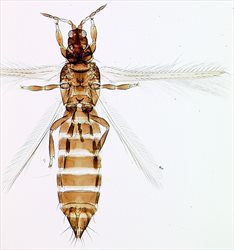
Female
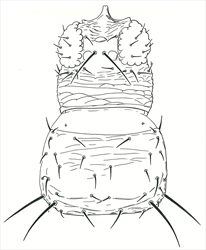
Head & pronotum
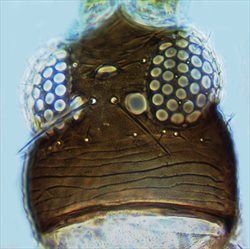
Head

Antenna

Antenna
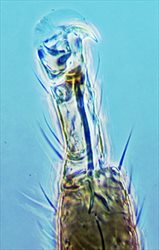
Fore tarsus with apical claw

Fore tarsus
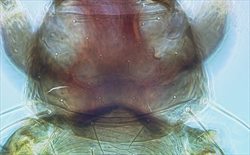
Pronotum

Tergites VII-VIII
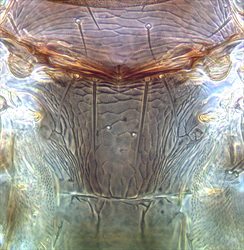
Meso & metanota
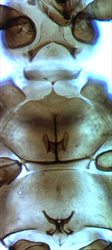
Thoracic sternites
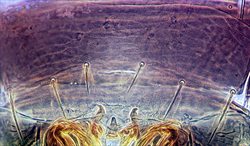
Female sternite VII
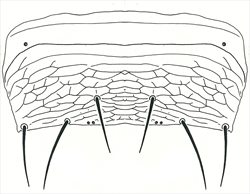
Female sternite VII

Fore wing
Both sexes fully winged. Body brown, with yellowish brown tarsi and antennal segment III; fore wings light brown, base pale but extreme apex darker. Antennae 8-segmented; segments III–IV each with forked sense cone. Head longer than wide, projecting slightly in front of eyes; without sculpture between ocelli; two pairs of ocellar setae present, pair III as long as distance between compound eyes, arising between hind ocelli. Pronotum with few discal setae, 2 pairs of long posteroangular setae; posterior margin with one pair of small setae laterally, also one pair of prominent setae medially arising in front of margin. Fore tarsal pulvillus with recurved claw at apex. Metanotum weakly reticulate; median setae at anterior margin; campaniform sensilla present. Fore wing first vein with 2–4 setae on distal half; second vein with complete row of about 14 setae. Abdominal tergites with no sculpture medially; tergites VI–VIII with median setae at least half length of tergite; tergite VIII with posteromarginal comb of long regular microtrichia. Sternites without discal setae, VII with setal pair S1 arising in front of margin.
Male smaller than female; sternites V–VII with small pore plate medially.
Currently there are 51 species listed in the genus Taeniothrips, but 21 of these are known only from fossils. Of the remaining species, four are European in origin, one is from western North America, and the rest are from Asia (Mound, Azidah & Ng, 2012). T. inconsequens can be distinguished from T. picipes by the presence of a hook-like claw associated with the fore tarsal pulvillus.
Commonly associated with species of Rosaceae, this thrips also occurs on Acer species [Aceraceae]. In northeast USA, where it has been introduced, it is a pest of sugar maple trees.
In Britain, reported widely from Kent to Caithness (Mound et al., 1976). Widespread across the Palaearctic, from Iceland southeast to Iran, but also found in North America where it is known as the Pear Thrips.
THRIPIDAE - THRIPINAE
Taeniothrips inconsequens (Uzel)
Physopus inconsequens Uzel, 1895: 117
Euthrips pyri Daniel, 1904: 294
Physothrips calcaratus Bagnall, 1916: 221
Taeniothrips inconsequens ab. adustus Priesner 1920: 55
Mound LA, Azidah AA & Ng YF (2012) Key to the non-fossil species of the genus Taeniothrips (Thysanoptera, Thripidae). Zootaxa 3414: 33–42.
Mound LA, Morison GD, Pitkin BR & Palmer JM (1976) Thysanoptera. Handbooks for the Identification of British Insects 1 (11): 1–79.